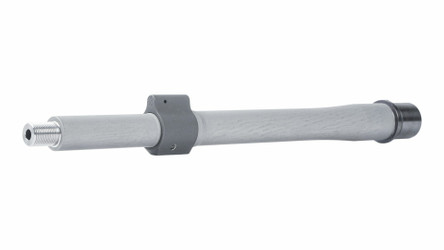Complete Guide to AR-15 Barrels
Posted by Doug Shoemaker on May 26th 2022
If you have looked into upgrading an AR-15 at any point in time, you have most likely seen many different barrel options available.
We produced this guide to help you understand the different AR-15 barrel options to choose the best option for yourself.
Barrel Length
First, consider what you will be doing with your rifle. How will you use it? Here are some other things to consider when looking at AR-15 barrel length.
First, AR-15 Barrels come in lengths as short as 7" to 24" long. However, the most common barrel length is 16". The ATF requires any rifle with a barrel shorter than 16" to carry a Class III tax stamp.
Generally, the greater the distance you intend to shoot, the longer the barrel should be. This is because a longer barrel offers sufficient pressure to attain higher acceleration and increased accuracy. However, remember that longer barrels are more challenging to maneuver. This is especially the case in close quarters. Additionally, longer barrels are heavier and more costly.
Shorter barrels make it easier to maneuver in confined areas. Still, it comes with a trade-off of lower velocity.
If you need an accurate and maneuverable gun, it's probably best to start with a 16" barrel. However, there are other options to consider.
Barrel Materials
The majority of AR-15 owners can get by with a standard barrel. Only very heavy users will require a cold-hammer-forged barrel's more significant long-term benefits.
Cold hammer forging produces a tougher, more durable barrel with a longer lifespan that performs better, especially when hot from extreme use. However, these barrels are generally heavier than their standard counterparts.
Additionally, the cost is higher because there are only a few cold hammer machines in use today and the added time it takes to manufacture. So, be ready to spend more if you require a cold hammer-forged barrel.
A stainless-steel barrel, or "match barrel," is another option. This barrel provides increased accuracy at longer ranges. In addition, there is little worry of the slightly increased chance of wear or corrosion if adequately maintained for occasional to moderate shooters.
Barrel Profile
AR-15 profiles are separated into three basic categories: lightweight, government, and heavy. One thing to consider is that the heavier the barrel, the greater the resistance it provides to heat buildup while firing.
A heavier barrel typically lasts longer than a lighter one, making it a better choice for frequent AR-15 users without weight concerns. On the other hand, a more lightweight barrel makes the rifle easier to carry and control.
The most common option is the M4 government profile. It offers an excellent compromise of weight and maneuverability. In addition, many AR-15 owners are now opting to have multiple uppers for their lower to swap them depending on the day's tasks.
You can buy complete uppers or put in the effort to build a custom one that meets your needs.
Interior: Chrome vs. Nitride
Mil-spec AR-15 barrels typically include a chrome-moly steel lining. The chrome lining is beneficial for use in high-humidity and saltwater environments as it offers improved corrosion resistance. The chrome also protects against friction-reducing heat, helping to extend barrel lifespan. Additionally, many people find chrome barrels easier to clean.
However, these barrels do come with some disadvantages. For example, chrome-lined barrels can reduce accuracy at long distances (over 300 yards). This is due to unevenness and potential high points in the plating process.
Nitride is typically less expensive as it is easier to produce and comes with many of the same advantages without actually coating the barrel. This maintains barrel integrity and decreases the opportunity for unevenness and high points.
For anyone who is not firing full-auto or operating the rifle for extreme lengths of time under poor environmental conditions nitride is a great option.
Barrel Twist Rate
Barrel twist rate refers to the rifling inside the barrel that causes the bullet to rotate before exiting. The barrel's twist rate describes how many rotations a bullet will make in relation to the number of inches it travels within the barrel.
For example, a twist rate of 1:7 means the bullet will travel 7" to perform one complete rotation. Barrels with a 1:7 twist ratio enable a bullet to spin faster than those with a 1:9 or 1:12 ratio. A quicker rotation increases bullet stability after exiting the rifle. The most common is a 1:7 twist ratio.
Before choosing a twist rate, consider the weight of bullet you will be using. Common twist ratio to ammo grain combinations are:
- 1:9 = 40, 45 & 50 grain
- 1:8 = 55 & 62 grain
- 1:7 = 75 & 77 grain
An AR-15 Barrel is a part of the weapon that becomes more important the more familiar you become with using the gun. For beginners, we suggest buying a stock firearm and deciding how deeply you want to get into the hobby of shooting.
If you are using your AR-15 for more than just target practice at the shooting range, consider all the requirements before purchasing.
AR-15 Barrel Recommendations
If you are looking for a high-quality AR-15 barrel, we recommend one of these suppliers:
For more AR-15 information, deals, and news, subscribe to our email below!

